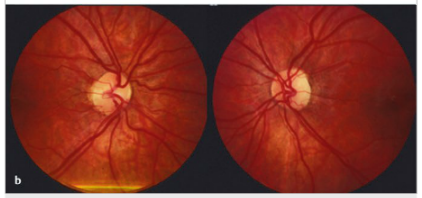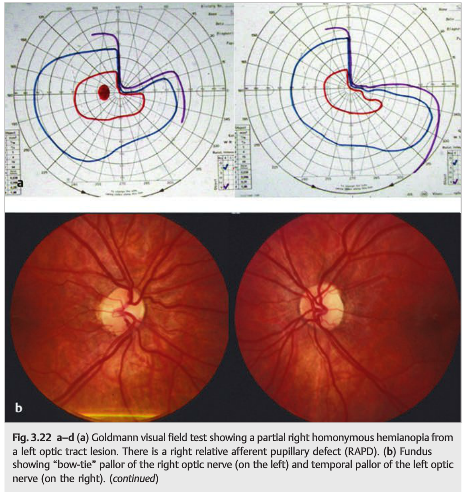Question:
Which of the following are correct for a left optic tract lesion?
1. Right homonymous hemianopia
2. Left RAPD
3. Bowtie atrophy of the right optic nerve
4. Mostly temporal pallor of the left optic nerve
 1
1
_______________________________________
Correct Answers:
1.Right homonymous hemianopia
3. Bowtie atrophy of the right optic nerve
4. Mostly temporal pallor of the left optic nerve
Explanation: “Optic Tract

Lesions of the optic tract cause a contralateral homonymous hemianopia, which may or may not be congruent. Optic tract fibers are the axons of the ganglion cells originating in the inner layers of the retina. These axons are destined for the lateral geniculate nucleus, where they synapse with neurons whose axons then form the optic radiations. Therefore, chronic optic tract lesions will cause optic atrophy, often in a characteristic pattern.
Lesions of the optic tract (left optic tract lesion in the example in ▶Fig. 3.22) produce atrophy of three groups of retinal ganglion cell fibers:
1. Nasal half of the macula of the right eye ([1–red] in ▶Fig. 3.22d)
2. Nasal retina of the right eye ([2–red]) in ▶Fig. 3.22d)
3. Temporal retina in the left eye ([3–green] in ▶Fig. 3.22d)
Lesion groups 1 and 2 result in a bowtie pattern of optic atrophy (▶Fig. 3.22b) of the right optic nerve. Lesion group 3 results in mostly temporal atrophy of the left optic nerve (▶Fig. 3.22b). A RAPD is often observed in the eye contralateral to the optic tract lesion. This is because more fibers in the optic tract come from the opposite eye, having crossed in the chiasm. This greater contribution from the opposite eye is because the nasal retina is bigger than the temporal retina (the temporal visual field is bigger than the nasal visual field in each eye). The resultant RAPD will be in the eye that has contributed the most fibers to the damaged optic tract (i.e., the eye opposite the lesion, on the same side as the homonymous hemianopia).

Pearls
A left optic tract syndrome includes the following:
● Right homonymous hemianopia
● Right RAPD
● Bowtie atrophy of the right optic nerve
● Mostly temporal pallor of the left optic nerve”1
Reference: 1. Neuro-ophthalmology Illustrated-2nd Edition. Biousse V and Newman NJ. 2012. Theme
More than 600 additional neuro-ophthalmology questions are freely available at http://EyeQuiz.com.
Questions prior to September 2016 are archived at http://ophthalmology.stanford.edu/blog/
After that, questions are archived at https://neuro-ophthalmology.stanford.edu
Follow https://twitter.com/NeuroOphthQandA to be notified of new neuro-ophthalmology questions of the week.
Please send feedback, questions and corrections to tcooper@stanford.edu.